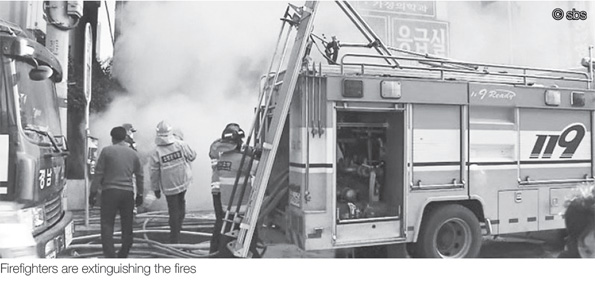
Recently, accidental fires have occurred repeatedly. On December 21, 2017, there was a big fire in Jecheon. Shortly afterward, a big fire happened in Sejong Hospital located in Gyeongnam. It started in the ceiling of the nurses’ fitting room. It caused forty-eight deaths, and everyone was saddened by the news. It is urgent to find out the causes and seek ways to prevent future fires.
Yu Moon-jong, a fire captain in the Chungnam Yesan Fire Station, pointed out two things as causes of these disasters. First, he pointed out the use of an Exterior Insulation Finishing System(EIFS). He said, “EIFS was used in the exteriors of the buildings in Jecheon and Miryang, where the fires happened. Therefore, the fires rapidly expanded and became major fires. To prevent fires, architects have to use non-flammable fireproof materials when constructing buildings.”
The second reason why these fires caused great casualties is that Sejong Hospital held more patients than the number of patients allowed by regulations, so the right number of medical personnel was lacking. Although the number of beds was doubled, the number of medical personnel remained the same for 10 years. The right number of medical personnel would have been six doctors and thirty-five nurses according to the Health and Welfare Ministry, but there were only three doctors and three nurses.
Experts pointed out four reasons why disasters have continued in Korea. First, the lack of legal and institutionalized fire prevention installation is one cause. Under the current law, when general hospitals have a floor area of ‘at least 11 floors’ or ‘more than 4 floors and more than 1,000m² on one floor’, it is mandatory to install sprinklers. The area for each floor of Sejong Hospital was 213~355m², so the sprinklers were not necessary.
Yu Moon-jong, a fire captain in the Chungnam Yesan Fire Station, said, “Firefighting facilities should be mandatory in small buildings. The responsibilities of builders also needs to be strengthened to ensure that the installed firefighting facilities are managed properly, and if not, the owner of the building can be held liable for a fine.”
The second reason is disregard for safety. Sejong Hospital had been conducting a fire safety self-inspection. The Chief of the General Affairs Department of Sejong Hospital self-checked and submitted ‘self-safety check’ results three times in the last three years and reported, “No Problems.” Disregard for safety and a lack of awareness or familiarity with safety rules resulted in the results of “No Problems.”
The third reason is a lack of willingness to abide the inconvenience of safety rules. Developed countries view security costs as necessary. The people are only willing to pay for what’s in their interest. Although there are public parking lots, they illegally park to save money, and residents don’t mind storing their items on emergency stairs. In developed countries, people view the inconvenience of security as expected and necessary. In Korea, its people consider such people as fools or nuts.
The fourth cause of the constant disasters is the lack of corporate responsibility. Kang Moon-dae, a lawyer, said, “Poor safety management is due to the weak penalties under the current law. Corporations and senior managers can be held liable only in a very limited and roundabout way. We need to increase the penalties and clarify where the responsibility lies.”
The Jecheon and Miryang disasters were not instant incidents. They were disasters that came about because of a buildup of conditions that increased the likelihood of accidents. Prevention of such huge accidents needs legal and institutional mechanisms, a mature sense of safety by the people, and corporate awareness about safety.
By Park Jeong-min
jm38@cbnu.ac.kr


 All
All Society & Global
Society & Global






 Park Jeong-min
Park Jeong-min











